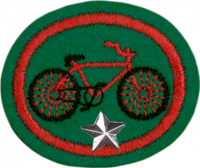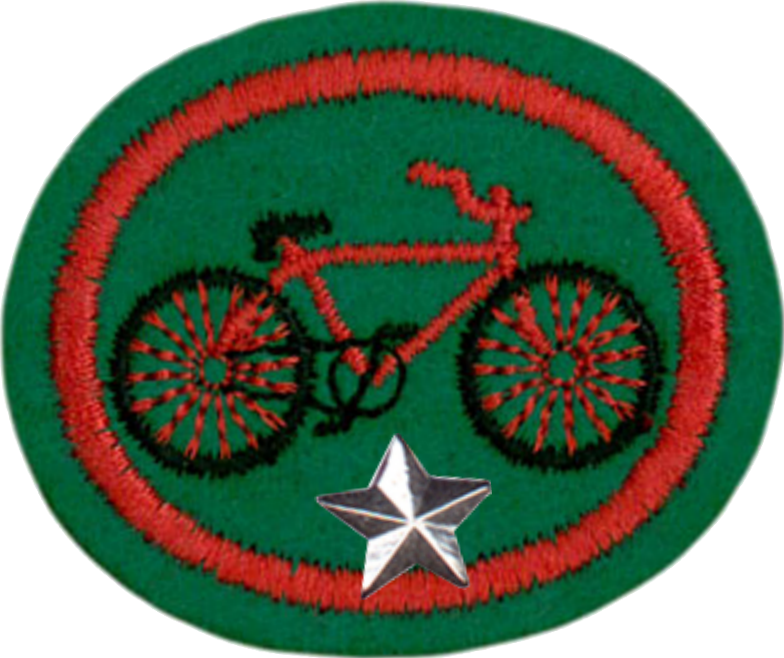Especialidades JA/Ciclismo - Avanzado/Respuestas 2
Nivel de destreza
2
Año
1976
Version
12.01.2025
Autoridad de aprobación
División Norteamericana
The following is from the National Highway Traffic Safety Administration (and therefore free to reprint and reuse)
Bicycle riding is fun, healthy, and a great way to be independent. But it is important to remember that a bicycle is not a toy; it’s a vehicle! Be cool – follow some basic safety tips when you ride.
Safe Riding Tips Before using your bicycle, make sure it is ready to ride. You should always inspect your bike to make sure all parts are secure and working properly. Remember to:
Wear a Properly Fitted Bicycle Helmet. Protect your brain, save your life. For more information see the National Highway Traffic Safety Administration publication “Easy Steps to Properly Fit a Bicycle Helmet.”
Adjust Your Bicycle to Fit. Stand over your bicycle. There should be 1 to 2 inches between you and the top tube (bar) if using a road bike and 3 to 4 inches if a mountain bicycle. The seat should be level front to back. The seat height should be adjusted to allow a slight bend at the knee when the leg is fully extended. The handlebar height should be at the same level with the seat.
Check Your Equipment. Before riding, inflate tires properly and check that your brakes work.
See and Be Seen. Whether daytime, dawn, dusk, foul weather, or at night, you need to be seen by others. Wearing white has not been shown to make you more visible. Rather, always wear neon, fluorescent, or other bright colors when riding day or night. Also wear something that reflects light, such as reflective tape or markings, or flashing lights. Remember, just because you can see a driver doesn’t mean the driver can see you.
Control Your Bicycle. Always ride with at least one hand on the handlebars. Carry books and other items in a bicycle carrier or backpack.
Watch for and Avoid Road Hazards. Be on the lookout for hazards such as potholes, broken glass, gravel, puddles, leaves, and dogs. All these hazards can cause a crash. If you are riding with friends and you are in the lead, yell out and point to the hazard to alert the riders behind you.
Avoid Riding at Night. It is far more dangerous to ride at night than during the day because you are harder for others to see. If you have to ride at night, wear something that makes you more easily seen by others. Make sure you have reflectors on the front and rear of your bicycle (white lights on the front and red rear reflectors are required by law in many States), in addition to reflectors on your tires, so others can see you. Many bicycle-related crashes resulting in injury or death are associated with the bicyclist’s behavior, including such things as not wearing a bicycle helmet, riding into a street without stopping, turning left or swerving into traffic that is coming from behind, running a stop sign, and riding the wrong way in traffic. To maximize your safety, always wear a helmet AND follow the rules of the road.
Rules of the Road – Bicycling on the Road
Bicycles in many States are considered vehicles, and cyclists have the same rights and the same responsibilities to follow the rules of the road as motorists. When riding, always:
Go With the Traffic Flow. Ride on the right in the same direction as other vehicles. Go with the flow – not against it.
Obey All Traffic Laws. A bicycle is a vehicle and you’re a driver. When you ride in the street, obey all traffic signs, signals, and lane markings.
Yield to Traffic When Appropriate. Almost always, drivers on a smaller road must yield (wait) for traffic on a major or larger road. If there is no stop sign or traffic signal and you are coming from a smaller roadway (out of a driveway, from a sidewalk, a bike path, etc.), you must slow down and look to see if the way is clear before proceeding. This also means yielding to pedestrians who have already entered a crosswalk.
Be Predictable. Ride in a straight line, not in and out of cars. Signal your moves to others.
Stay Alert at All Times. Use your eyes AND ears. Watch out for potholes, cracks, wet leaves, storm grates, railroad tracks, or anything that could make you lose control of your bike. You need your ears to hear traffic and avoid dangerous situations; don’t wear a headset when you ride.
Look Before Turning. When turning left or right, always look behind you for a break in traffic, then signal before making the turn. Watch for left- or right-turning traffic.
Watch for Parked Cars. Ride far enough out from the curb to avoid the unexpected from parked cars (like doors opening, or cars pulling out).
Sidewalk versus Street Riding
The safest place for bicycle riding is on the street, where bicycles are expected to follow the same rules of the road as motorists and ride in the same direction.
- Children less than 10 years old, however, are not mature enough to make the decisions necessary to safely ride in the street.
- Children less than 10 years old are better off riding on the sidewalk.
For anyone riding on a sidewalk:
- Check the law in your State or jurisdiction to make sure sidewalk riding is allowed.
- Watch for vehicles coming out of or turning into driveways.
- Stop at corners of sidewalks and streets to look for cars and to make sure the drivers see you before crossing.
- Enter a street at a corner and not between parked cars. Alert pedestrians that you are near by saying, “Excuse me,” or, “Passing on your left,” or use a bell or horn.
For more information on bicycle safety, visit the National Highway Traffic Safety Administration (NHTSA) Web site at: www.nhtsa.dot.gov
Drafting (or slipstreaming) is a technique where two vehicles or objects align in a close group to reduce the overall effect of drag by using the lead object's slipstream. When high speeds are involved, drafting can significantly reduce the group's average energy expenditure needed to keep a certain speed and can slightly reduce the energy used by the lead vehicle or object.
Drafting is used to reduce wind resistance and is seen most commonly in bicycle racing, car racing, and speed skating, though drafting is occasionally used even in cross-country skiing and running. Some forms of triathlon allow drafting. Drafting occurs in swimming as well, both in open-water races (occurring in natural bodies of water) and in traditional races in competition pools. In a competition pool, a swimmer may hug the lane line that separates him/her from a swimmer of whom s/he is abaft, thereby taking advantage of the liquid slipstream in the other swimmer's wake.
In cycling, the main (largest) group of tightly packed cyclists in a race is called a peloton, while cyclists riding in straight-line formation, each (but the first) drafting behind the one in front of him, is called a pace line.
Drafting can be cooperative, in which several competitors take turns in the lead position (which requires the most effort and energy consumption). Or, it can be competitive or tactical, where one competitor will try to stay closely behind another leaving him or her more energy for a break-away push to the finish line.
Different types of cycling have different clothing and protective gear. However, some are common to all cycling:
- Helmet - protects head in the event of an accident, can provide sun shade and protection. Are required in some places, or for some ages.
- Gloves - protects hands, usually the first body part to hit the ground in the event of an accident; padding in gloves eases fatigue and can provide some shock-absorption. Gloves protect road-riders' hands when cleaning glass, gravel, etc., from tires while riding.
- Glasses - keeps bugs and debris out of the eyes, and keeps eyes from watering in cold weather or high-speed rides. Sunglasses reduce glare and keep eyes from becoming over-tired.
General safety equipment which is not required, but used by some cyclists includes:
- Mirrors - these attach to the handlebars or rider's helmet for seeing cars/cyclists behind. These can be important for commuters, bicycle messengers, or those cycling in urban/suburban environments.
- Bells - mountain bikers on hidden single-track trails, or cyclists in busy areas may use handle-bar mounted, finger-activated bells to warn of approach.
Riding at night has it's own safety requirements:
- Front and rear lights - these are required in some locales after sunset.
- Reflectors - mounted on wheels, pedals, frame, seatpost or handlebars are the most common.
- Reflective clothing - many makers of cycling clothing integrate reflective tape or strips on shoes, pants/shorts, shirts/jackets or helmets.





